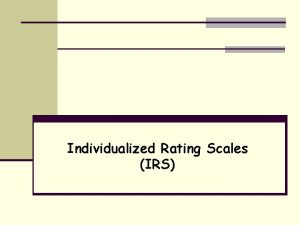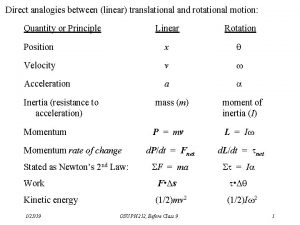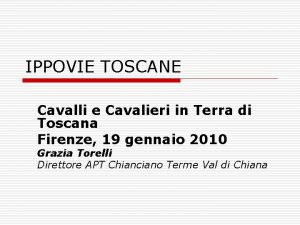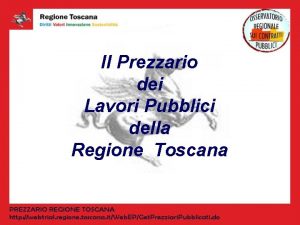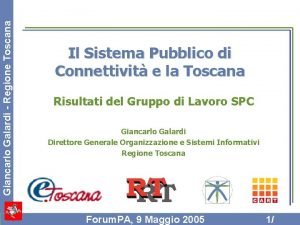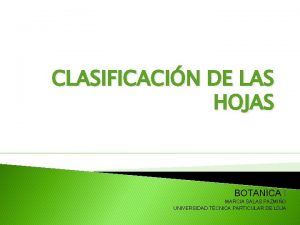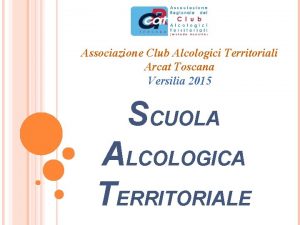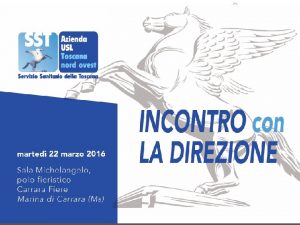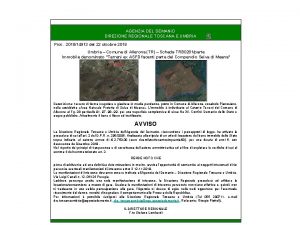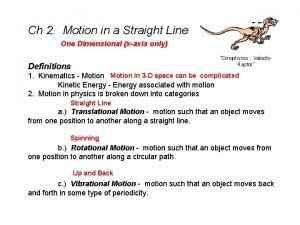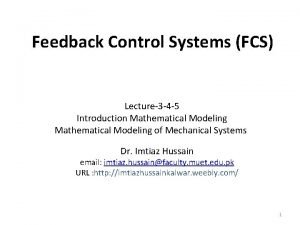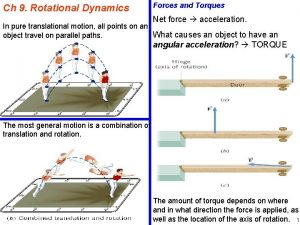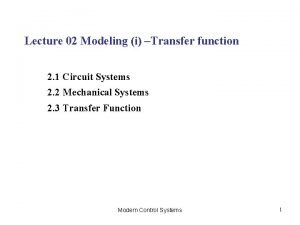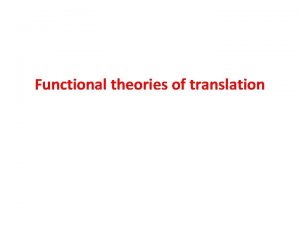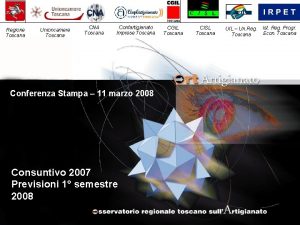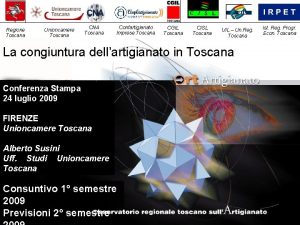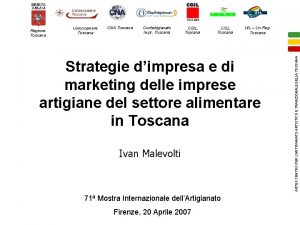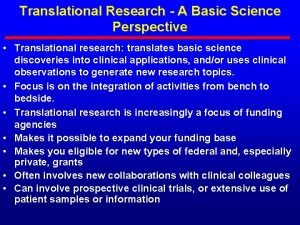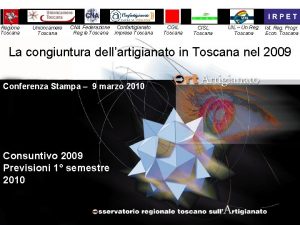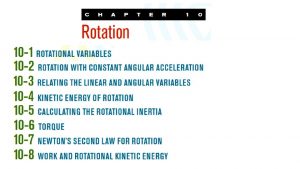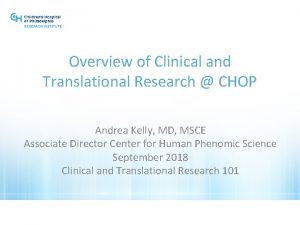Individualized research and translational medicine Andrea Frosini Toscana



















































- Slides: 51

Individualized research and translational medicine Andrea Frosini Toscana Life Sciences Foundation

Outline • • • The change: towards individualized research Research in an individualized context The crisis in the valorization system New values for translational medicine Clinical research meets narration The confluence

Outline • • • The change: towards individualized research Research in an individualized context The crisis in the valorization system New values for translational medicine Clinical research meets narration The confluence

“If it were not for the great variability among individuals, medicine might as well be a science and not an art” Sir William Osler, 1892

Individualized research and precision medicine

As of September 11, 2015, 369 organizations have submitted 158, 668 genetic variations to Clin. Var (a database of the NCBI). Approximately 2, 000 of these have had dissimilar interpretations by the same people that loaded the information. Aronson et al. , Nature (vol. 526), Oct. 2015

Outline • • • The change: towards individualized research Research in an individualized context The crisis in the valorization system New values for translational medicine Clinical research meets narration The confluence

The basis of precision medicine The concept of micro-heterogeneity lies at the basis of individualized research, as the incidence of individual or idiosyncratic molecular variations; for this reason, in a certain sense it is not possible to speak of “normal” in this context. Biomarkers and “omics” profiles (fingerprints) A biomarker is a molecular, biological or physical attribute that characterizes, with others, a specific (patho)physiological state and that can be measured and evaluated objectively to identify or define the progression of a disease, or predict and quantify a therapeutic response. In particular, reference is made to the “omics” profiles of individuals, giving the following values to the observation: ü preventive (risk of developing the pathology), ü diagnostic (presence of a pathology), ü prognostic (stratification of the risk of progression of the pathology), ü therapeutic (measure of response to therapy)

Biomarkers in research • Biomarkers play a central role in individualized research. Approximately 50% of the medicines that have been developed to date are associated with a particular biomarker. • Biomarkers are already used to direct the enrollment of patients (“enrichment”). • The same complexities encountered in personalized scientific investigation directly reverberate in the regulatory, legal and economic spheres.

Clinical trials Randomized controlled trials (RCT) are considered the sine qua non of applied research in medicine. The purpose is an objective evaluation of the benefits and problems associated with new clinical interventions directly compared with standards or placebos in order to claim efficacy and utility.


Precision vs. imprecision medicine Attempts to fractionate or stratify the larger population into smaller groups likely and not likely to benefit from specific treatments.

Precision medicine requires a different type of clinical trial that focuses on individual, not average, responses to therapy. • • Erbitux (cetuximab) improves the survival of people with colorectal cancer whose tumor cells carry a mutated EGFR gene but not a mutated KRAS gene. Herceptin: monoclonal antibody used for a tumor subtype associated with the oncogene ERBB 2. $200 million was sold in 2008 for an efficacy of 25 -30% in women belonging to the subtype. Gleevec – imatinib: inhibitor of the tyrosine kinase BCR-ABL for the treatment of myeloid leukemia. It was found to double survival rates of leukemia patients with a chromosomal abnormality in their tumors called the Philadelphia translocation. Since 2009 there have been problems in diffusing the treatment due to costs (Korea) and patent issues (India). Vectibix: drug for the treatment of colon cancer. Approved in the US by the FDA and rejected in Europe. The demonstration of greater efficacy in patients in which chemotherapy fails and who are positive for EGFR reversed the situation in Europe. On the other hand, then, the FDA withdrew its favorable opinion. This approach to discovery is inefficient at best. Conventional phase II trials involve thousands of people. The intervention being tested is often given at random to one group.

Changing the paradigm • Researchers need to probe the myriad factors – genetic and environmental, among others – that shape a person’s response to a particular treatment. • Various trial designs have been developed that better account for variability among patients. • Examples: – – – Bucket (basket) Umbrella Tent Adaptive … towards “N-of-1” clinical trials

Bucket • Bucket (basket) trials, which have mainly been used for cancer, test the effectiveness of an intervention on the basis of its mode of action, regardless of what disease it was designed to treat. • The effectiveness of the different matches of treatment to genetics will be compared as the trial unfolds. © Dr Frank Hermann

Umbrella • In umbrella trials, researchers test the effectiveness of multiple drugs in a study of a single disease. • Here, the effectiveness of matches between drugs and genetics will be compared with standard care. © Dr Frank Hermann


Adaptive trials • Adaptive trials aim to match interventions to patients while the study is ongoing, on the basis of patient responses. © Dr Frank Hermann



Toward “N-of-1” trials? • Single subject trials consider an individual patient as the sole unit of observation in a study. • Such trials leverage study design and statistical approaches associated with standard trials. • Research is moving toward the possibility of collecting data from a single-patient clinical-trial, with the perspective of transforming everyday clinical care into solid N-of-1 trials. • Examples already ongoing (in Australia and Canada).

Toward “N-of-1” trials? • A major advantage of the N-of-1 approach over classical trials is that patients, whose involvement in a study may only help future generations, are no longer guinea pigs. In N-of-1 trials, the effectiveness of different treatments is vetted for the actual participants. Indeed, members of hundreds of patient advocacy groups, for instance for rare genetic diseases, are eager to be involved in studies to test candidate drugs. • For example, cell-phone-based mood, activity and pain level diaries, although not completely invisible to a patient, could be used to assess the efficacy of antidepressants, anxiolytics, analgesics and other palliative interventions. Cell phone diaries could also be used to record mild side effects of interventions, as well as compliance with an intervention, and hence complement symptom monitoring.

Research in personalized medicine… • Some people propose subdividing the vision of the future of personalized medicine in: – “explicit” (based on scientifically identified and understood relationships) – “implicit” (“black box medicine” – when these relationships are not defined, and are directly based on opaque algorithms). • In the case of the development of black box medicine, computer systems and artificial intelligence can be used to determine solutions and correlations on the basis of aggregated “omics” data. Nicholson Price, Harvard Journal of Law & Technology (2015)

Outline • • • The change: towards individualized research Research in an individualized context The crisis in the valorization system New values for translational medicine Clinical research meets narration The confluence

Impact on the current system for valorizing research Commercial Determinants of the value of research Ethical Scientific Legal

Intellectual property of biomarkers Diagnostic tests in this context cannot be patented, as they are based on purely natural principles or phenomena. • BRCA 1 and BRCA 2 are the genetic loci relating to certain forms of breast and ovarian cancer. Myriad Genetics has extracted a series of consensus sequences on the two genes and requested the relative patents. The products of these genes are key proteins that contribute to DNA repair. • The Myriad patents have been revoked (USPTO) or strongly limited in their scope (EPO).

Laws of nature cannot be patented… • Laboratory Corporation of America vs. Metabolite Laboratories (2006) – Patent on the evaluation of homocysteine levels for the diagnosis of vitamin deficiencies. The patent covered the inference mechanism, by reading the level of homocysteine upon the diagnosis of cobalamin and folate deficiencies. The judges evaluated the correlation between biomarkers and vitamin levels to be a natural phenomenon, and therefore not patentable. • Mayo Collaborative Services vs. Prometheus Laboratories (2012) – Patent on the correlation between thiopurine levels and the treatment of autoimmune diseases. The patent covered the method for adjusting the dose of the drug on the basis of a measurement of the thiopurine levels in the patient’s plasma. The judge laid down a sentence to withdraw the patent as a “mere set of instructions to the physician on how to aggregate data from which to be able to infer the best treatment”. • Association for Molecular Pathology vs. Myriad Genetics (2012) – The patents covered the use of BRCA 1 and BRCA 2 to predict the development of breast and ovarian cancer, through a process of analysis and comparison of the sequences of patients with “normal” sequences to make a diagnosis. The patent was denied as it essentially described the mental method for comparison and analysis. • …

The base for a new type of valorization of the results of individualized research • Keeping an inference model or a set of data secret, as an alternative to the patent, disregarding wider considerations, cannot guarantee simple validation processes and reduces the impact of research on innovation. • Myriad has developed a database for variants BRCA 1 and 2 that allows only 3% of insignificant and non-correlatable genetic variants to be achieved, as opposed to the 20 -30% of the competitors. Myriad’s business model is that of secrecy. • More general doubts regarding the ethics of keeping these results secret are quite evident.

The Myriad example opens new horizons BRCA 1 and 2 are highly polymorphic genes, and therefore exist in a high number of allelic variants. The more alleles that a laboratory knows about, the more complete and robust the developed test will be. Access to information becomes crucial: in this framework, Myriad maintains a competitive advantage as a result of the aggregated data held as an industrial secret and obtained from thousands of patients over about 15 years. An effort to reconstruct the Myriad database by third parties will necessarily be uncertain and costly. In a wider context, different laboratories can hold subgroups of information, the exchange of which, in an economic context in which Arrow’s information paradox applies, would find themselves faced with the “prisoner’s dilemma”. The personal data contained in a database shows characteristics similar to the effects of “economic networks”: they acquire value if associated together and with other data.

Arrow’s information paradox Arrow, Kenneth J. Economic Welfare and the Allocation of Resources for Invention, in The Rate and Direction of Inventive Activity, 609 (Nat’l Bureau of Econ. Research ed. 1962) • Arrow’s information paradox diagnoses a genuine problem in trading information • It depends on the seller’s capability (the likelihood of having the information) and reliability (the likelihood of disclosing the information) and the relevance of the information for the buyer (the utility of correct information when received) • Differences in capability and reliability, i. e. whether one is more likely to have and/or to disclose the information, may also solve the appropriation problem of the supply side, which is illustrated with tentative models of producer and consumer markets

Basis for a new valorization • The primary benefit of individualized research, which lies in a greater penetration of the drug due to an improved stratification of patients, will reduce the reference market (a vision in which every disease will be “rare”). • There is an evident positive impact of precision medicine on theme of “appropriateness”! • Innovation and commercialization depend on regulatory frameworks and intellectual property rights, which must certainly be reviewed on the basis of the above.

Outline • • • The change: towards individualized research Research in an individualized context The crisis in the valorization system New values for translational medicine Clinical research meets narration The confluence

Companion Diagnostics • Patents that combine the use of biomarkers with new and innovative treatment programs remain valid: “companion diagnostics”

New paradigms for valorization • In market terms, a similar version of the same problem appears in copyrights, and in particular in “original” art, such as sculpture or painting, where single instances of original pieces are created. When the return of exclusivity is linked to a single instance, its price becomes exorbitant. The price of personalized medicine would be unsustainable. • The artist, in order to have a congruous return, produces original copies as a sales strategy…

The example of the BCCA • An excellent example of innovative development in this context is given by the experience of the British Columbia Cancer Agency (BCCA). The BCCA holds data relative to “genomic signatures” of tumor biopsies, which correlate with the treatment course and with other physiopathological data of the patients. These are recognized as the patient’s information, not as a source of patent disclosure; toward individualized research and personalized medicine. BCCA develops commercial agreements with private partners with which to develop new diagnostic, prognostic, and theragnostic tests on the basis of their relational databases.

Licensing Societies • Copyright laws have produced Licensing Societies that collectively administrate the rights of individual artists (e. g. music in Spotify), so that the consumer buys the right to access to a certain song in a context in which the direct purchase would be too expensive. The fee paid results from the dilution of the access rights paid once by millions of buyers, which the Licensing Society then shares with the authors. • The same framework can be imagined for the use of aggregated data of an individualized type, for which valorization could result from an aggregation of data kept secret, to which access can be given pro-rata each time that the database is interrogated. • This type of approach is also valid for research biobanks, which would also resolve the problem posed by legal constraints on the direct use of biological material.

Innovative paradigms applicable Netflix and Pandora are examples that can illustrate an “implicit” precision medicine approach. Pandora is based on “content-based filtering” techniques that propose recommendations to users on the basis of a match between the technical characteristics of the subject and the preferences expressed by the user. When a user selects a song, the suggestion regards songs with the same musical “pattern”. Netflix uses “collaborative filtering” techniques, using information based on groups of users that make analogous choices, constructing a predictive model that therefore makes recommendations.

Outline • • • The change: towards individualized research Research in an individualized context The crisis in the valorization system New values for translational medicine Clinical research meets narration The confluence

The management of information

Clinical research towards a narration The symbolic relevance of feedback: return and disclosure of genomic research results of breast cancer patients in Belgium, Germany and the UK Petersen et al. , J Clin Res Bioeth 2014, 6: 4 • • • Exploring participant attitudes and perceptions about privacy concerns and expectations of receiving study results in three national study populations (Belgium, n = 152, United Kingdom, n = 122, and Germany, n = 122). The recruited survey participants were breast cancer patients who provided biospecimens to genomic cancer research. Despite their consent to participate in research, they had considerable concerns regarding personal risks of disadvantage from privacy violations in the context of the research setting and were fairly unconfident whether existing data protection measures adequately safeguard them. Can some forms of reciprocity provide a way out of the dilemma? The return does not necessarily have to be beneficial in terms of money or patient care, but needs to represent some sort of appreciation of the study participant’s contribution.

Clinical research towards a narration Disclosing pleiotropic effects during genetic risk assessment for Alzheimer’s disease Christensen et al. , Annals of Internal Medicine, 2016, 164: 3 • 257 asymptomatic adults were enrolled, 69% of whom had 1 AD-affected first-degree relative. Adults from Boston, Massachusetts, Cleveland, Ohio, Washington, DC and Ann Arbor, Michigan. • Primary outcomes were Beck Anxiety Inventory (BAI) and Center for Epidemiologic studies Depression Scale (CES-D) scores at 12 months. • Participants at increased risk for disease (APOE ε 4 carriers) seemed to experience less test-related distress at 12 months if they also received CAD information. • Learning about an increased risk for AD and addressing pleiotropic outcomes may motivate persons to be healthier in general rather than motivating them to take steps to reduce risk for a specific disease.

Outline • • • The change: towards individualized research Research in an individualized context The crisis in the valorization system New values for translational medicine Clinical research meets narration The confluence

A trajectory shared at a global level

A trajectory shared at a global level • US President Barack Obama unveiled a $215 million precision medicine program. The White House is seeking $130 million for the US National Institutes of Health (NIH) to develop a national cohort of at least one million volunteers for a longitudinal study. The challenge is related mainly to how well it can incorporate data from existing studies.

A trajectory shared at a global level • The California Initiative for Advancing Precision Medicine also follows similar initiatives in other countries. The state will spend another $600, 000 to study the ethical, legal and social issues related to such tailored treatment, among other issues. • The UK National Health Service will sequence the whole genomes of 100, 000 patients. • Researchers’ proximity to companies with expertise in handling big data or genetic information is key.

A trajectory shared at a global level • The Chinese government is expected to officially announce its initiative, which will certainly be larger and more expensive than the US initiative, after it approves its next five-year plan in March. • Leading institutes – including Tsinghua University, Fudan University and the Chinese Academy of Medical Sciences – are scrambling to set up precision-medicine centers. • Sichuan University’s West China Hospital, for instance, plans to sequence 1 million human genomes itself – the same goal as the entire US initiative. • In 2010, the genomics institute BGI in Shenzhen was estimated to host more sequencing capacity than the entire United States.

Quality of the data and organization • Given the complexity of the data that can potentially be aggregated, in order to develop individualized research there is a need for the creation of a precision research ecosystem that binds clinicians, researchers, companies and the systems charged with the aggregation of clinical information. • Standardizing the way in which the enormous amounts of personal data of patients is evaluated in diagnostic and prognostic terms is fundamental. • The robustness of clinical and research databases is a key point to guarantee the efficacy and quality of the interpretation of the data. • For this reason the organization of the information within dedicated databases is the resolving step for the foundation of an individualized research.

The Tragedy of the Commons • Hardin, in “The Tragedy of The Commons” (Science, 1968), questioned the sustainability of certain human practices and behaviors, making reference to the unpopular topic “freedom to breed”. These practices and behaviors are not innate, but derive from the system in which every man is trapped. • Some problems cannot be resolved technically, but only through an ethical approach.

Personalized medicine indicates a care paradigm that, on the basis of a more detailed knowledge of the patient, is able to diagnose and treat more effectively. Precision research is possible for market and technological questions, but the same does not hold for a personalization of medicine. Narration – as the relationship between physician and patient – can represent the true moment of personalization of medicine, in which ethical and relationship aspects also converge: toward a true medical art.

“Infatti la mente non ha bisogno, come un vaso, di essere riempita, ma, come legna da ardere, ha bisogno solo di una scintilla che la accenda, che vi infonda l'impulso alla ricerca e il desiderio della verità. ” “In fact the mind does not need, like a vase, to be filled, but, like wood to be burned, only needs a spark that lights it on fire, that infuses it with the impetus for research and the desire for the truth. ” The art of listening (De recta ratione audiendi), Plutarch of Cheronea

“If it were not for the great variability among individuals, medicine might as well be a science and not an art” Sir William Osler, 1892 …“The great variability among individuals makes medicine an art”!
 Justin frosini
Justin frosini Center for individualized medicine
Center for individualized medicine Duke translational medicine institute
Duke translational medicine institute Translational research institute on pain in later life
Translational research institute on pain in later life Howard schultz transformational leadership
Howard schultz transformational leadership Individualized consideration
Individualized consideration Idealized influence example
Idealized influence example Individualized instruction vs differentiated instruction
Individualized instruction vs differentiated instruction Individualized education plan
Individualized education plan Irs scale
Irs scale Individualized family service plan example
Individualized family service plan example Individualized healthcare
Individualized healthcare Translational and rotational motion
Translational and rotational motion Post translational and co translation
Post translational and co translation Analogy between linear and rotational motion
Analogy between linear and rotational motion Translational and rotational equilibrium
Translational and rotational equilibrium Ippovie della toscana
Ippovie della toscana Prezziario regione toscana
Prezziario regione toscana Giancarlo galardi regione toscana
Giancarlo galardi regione toscana Tipo de hojas
Tipo de hojas Artea toscana
Artea toscana Fiorellino prosecco
Fiorellino prosecco Corso toscana 108
Corso toscana 108 Geografia vitivinicola
Geografia vitivinicola Arcat toscana
Arcat toscana Ordine degli psicologi della toscana
Ordine degli psicologi della toscana Asl toscana
Asl toscana Psicologi toscana
Psicologi toscana Agenzia del demanio firenze
Agenzia del demanio firenze Translational equilibrium?
Translational equilibrium? Lj wei harvard
Lj wei harvard Translational kinetic energy
Translational kinetic energy Example of oscillatory motion
Example of oscillatory motion Translational kinetic energy
Translational kinetic energy Translational kinetic energy formula
Translational kinetic energy formula Translational motion definition
Translational motion definition Translational kinetic energy
Translational kinetic energy Translational vs rotational motion
Translational vs rotational motion Translational criminology
Translational criminology Rolling with slipping
Rolling with slipping Translational speed formula
Translational speed formula Translational mechanical system examples
Translational mechanical system examples Translational slide
Translational slide Translational motion equations
Translational motion equations Translational force
Translational force Translational partition function
Translational partition function How are uniform circular motion maps
How are uniform circular motion maps The first condition of equilibrium implies that: phy101
The first condition of equilibrium implies that: phy101 Translational mechanical system
Translational mechanical system Holz manttari translational action
Holz manttari translational action Translational fx
Translational fx Scope definition in research
Scope definition in research









